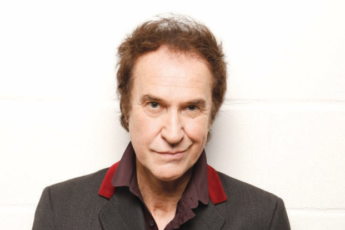It’s doubtful you would ever think of Steely Dan as a “guitar solo” band, and that’s true in part because their jazz/R&B/rock amalgam never made them a typical rock and roll group, but also due to the fact that their ostensible main guitarist, co-founder, Walter Becker, played only a fraction of them, and few of their most famous and recognizable ones. It was Larry Carlton’s virtuoso shredding on ‘Kid Charlemagne,’ Elliott Randall’s methodically slashing takes in ‘Reelin’ In The Years’ (playing what Jimmy Page once called his favorite guitar solo ever), Jeff “Skunk” Baxter romping amongst some of the band’s heaviest-ever horn arrangements in ‘My Old School,’ some Hoochie Koo blues from Rick Derringer in ‘Chain Lightning,’ and Jay Graydon emerging from among the attempts of no fewer than seven top studio session guitarists to ultimately record the biting solo keeper on ‘Peg.’ For the Steely Dan classic, ‘Bodhisattva,’ however, the fret-fraying guitar work was apparently so fierce, it required their recruitment of not one but two different savage soloists.
1973’s “Countdown To Ecstasy” was the Dan’s second album – coming just on the heels of their delectable debut, “Can’t Buy A Thrill,” and preceding the soon-to-come murderers row roster of “Pretzel Logic,” “Katy Lied,” “The Royal Scam,” and “Aja” in a 5-year spurt that was positively Creedence-like for prodigious brilliance – and ‘Bodhisattva’ was the record’s instantly distinctive opening track. Eight combined snare drum/high hat hits and two sets of two descending power chords, quickly followed by nine seconds of an oddly atonal piano chord sequence, all serve as introduction, before harmonized guitars arise to establish the tune’s main line. Those harmonies, presumably, are supplied by the two artists, Denny Dias and the aforementioned Skunk Baxter, who will soon be burning through the pair of solos that constitute the song’s hallmark (in typically cryptic Steely Dan fashion, the album’s liner notes identify the tune’s activity as “Dias the bebopper meets Baxter the skunk beneath the Bo tree in this altered blues.” Got it.). It’s Dias who’s featured first, winding through a full minute of remarkable runs beginning at 1:35, then Baxter arriving at 4:09 to fully set the song ablaze and finally deliver it’s charred husk, some 44 seconds later, to the climactic conquistador-like ending. It seems too obvious to assert how great a composition ‘Bodhisattva’ is, and any modest fan of classic rock has probably taken pleasure in its melodic joys scores of times. But seriously, go back and listen to it now specifically focusing on those two out-of-this-world solos. Together, they’re so stupefyingly incredible I think just hearing them could possibly bring about some sort of spiritual enlightenment.
Speaking of which, Bodhisattva: notwithstanding Steely Dan’s often indiscernible subject matter, the title does actually mean something. A Bodhisattva is a human who has reached a level of perfect enlightenment, as the Buddha did (whether or not by listening to righteous guitar solos), and can leave physical existence and the material world behind, but chooses to remain in human form in order to help others achieve such freedom. Donald Fagen, of course Walter Becker’s Steely Dan co-founder and remaining keeper of the flame following Becker’s death in 2017, said the song was “a parody on the way Western people look at Eastern religion – sort of oversimplify it.” In part, the idea that disposal of one’s possessions is a prerequisite to spirituality. “Lure of East, hubris of hippies, a quick fix,” Fagen noted. “We thought it was rather amusing, but most people didn’t get it.”
I doubt I’m alone in feeling that, in fact, it could frequently be hard to get Steely Dan. Somehow, accepting that convoluted mystique only added to both their lyrical and musical genius. Recently, along with my friend Kap and our respective better-halfs, I saw them live at New York City’s venerable Beacon Theater (the band basically being Fagen, now the one official member, at the helm leading a thoroughly impressive revue of professionals). Never anything close to a true touring group since all the way back to following the release of “Countdown To Ecstasy,” I did entertain some apprehensions as to whether that Steely Dan aura and musicianship would have survived the many decades of time since their ‘70’s heyday (not to mention the loss of one of its two originators). Our show, part of a five-night Beacon residency, was themed “By Popular Demand,” allowing Fagen to showcase a setlist of not only the band’s substantial list of hits but also many deep-cut, fan-favorites; they opened with the reggae-tinged “Royal Scam” number ‘Sign In Stranger,’ included “Can’t Buy A Thrill” nuggets ‘Dirty Work’ and ‘Brooklyn (Owes the Charmer Under Me)’ – the latter played live for the first time since 1974 – and sparkled with a personal highlight for Kap and I, the “Pretzel Logic” chestnut and utterly lovely minor-key mood of ‘Any Major Dude Will Tell You.’ They had all aged quite nicely. Late in the show the band broke out ‘Bodhisattva,’ that familiar drum opening raising much of the somewhat reserved, sophisticated-leaning audience to their collective feet. And, we all waited for the solos (plural). Yet interestingly, the power of two – Denny Dias and Skunk Baxter on the recording – was to be brought forth by just one: another guest guitarist, the estimable Jon Herington, long-time standout sideman and decade-plus member of Fagen’s touring ensemble, impressively proved up to both arduous soloing tasks. As his moments came, Herington casually inched forward on the stage, and calmly brought home the pair of intricate parts with a hint of panache and a nonchalant appearance of Zen placidity. I wasn’t certain if he’d reached a Bodhisattva level of true enlightenment, but I’m convinced he was at least damn close.







hotwachs
November 30, 2019 2:39 amAnother great review, and it made me think of the song a whole other way – especially the cover, which could be a nod (now I see) to the Hippies who went to India, gave up everything, shaved their heads, and became monks. And as you see on the cover of Countdown to Ecstasy, 3 dudes in chairs (shaved heads), waiting in a line for something – to become a monk (?). Thus, the title of the album (my guess, not researched).
Countdown was my least fav Dan album. Yet, My Old School and Bodhisattva never fail live.
And, I agree, “Any Major Dude” is certainly a quick-fix for happiness, as our 70s SD brains all remember. Funny, I was just speaking about the album “Pretzel Logic” with a mutual friend, Whammy Stammy, that Pretzel Logic is one of the most underrated Dan albums (Night by Night, Any Major Dude, Pretzel Logic).
Speaking of guitar solo – a high school friend got to work in a NYC recording studio as an assistant, Electric Lady, I believe. He brought back a secret tape recording of the Katy Lied album, and it was a recording of the engineering room, actually. I remember hearing the actual recording of Rick Derringer’s solo used on Chain Lightning. Gary Katz (SD regular producer) was heard shouting out, “Holy shit! That was amazing!”
I’m sure there were many an exclamatory during many a guitar solo recorded for many a Steely Dan song. Music makes you laugh, innately, when it takes you on journey, tackles the unexpected, goes outside the box, and returns you safely home with a smile, which Steely Dan accomplished time and time again with their 70s talent pool on those albums (as you so perfectly described as the ‘murderers row’).
Thanks again for making my brain think deeply so early in the am, mate. Thank God for The Dan.
Peace.
Lili free
November 30, 2019 5:53 amJust LOVE this blog! Thank you. Steely Dan are my favourite band and it’s wonderful to hear someone else wax lyrical about their multi-faceted brilliance. Saw them with my whole family a couple of years ago (sadly Walter had recently died) at the 02 arena, London and it really was one of the best concerts I’ve seen. There’s a great photo of ten of us playing air instruments, all in post-gig rapture. There are some bands that inspire even the “coolest” listeners to break out the air guitar and Steely Dan is definitely one of them.
Thomas Pirko
July 1, 2022 1:29 pmSkunk and Dias rocked it, but your prose is something to marvel at. My roommate told me who was Bodhisattva thirty years ago. Donald Fagan’s song reveals a bit of playful flippancy.
So Much Great Music
July 1, 2022 4:33 pmMany thanks and much appreciated, Thomas. Maybe the zen state hit me too : )
Thomas Pirko
July 1, 2022 7:34 pm*Coincidentally*, my brother in law moved to the Hamptons in 1968 and became a carpenter for the owner of MSG. He also worked for Sir Paul! Those men and a few others would call him on short notice if anything needed fixing.
Paul was tossing out his broken stereo receiver so I ended up carting it back to Ohio for a friend of ours who was a dedicated Beatlemaniac. That’s right up there with Jon Voight’s Plymouth!